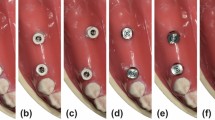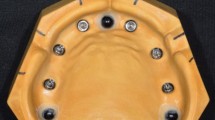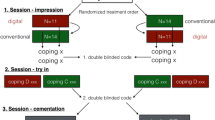Abstract
Dental restorations are increasingly manufactured by CAD/CAM systems. Currently, there are two alternatives for digitizing dental implants: direct intra-oral data capturing or indirect from a master cast, both with transfer caps (scanbodies). The aim of this study was the evaluation of the fit of the scanbodies and their ability of reposition. At the site of the first molars and canines, implants were placed bilaterally in a polymer lower arch model (original model), and an impression was taken for fabricating a stone cast (stone model). Ten white-light scans were obtained from the original and the stone model with the scanbodies in place. The scanbodies were retrieved after each scan and re-attached to the same implant or lab analogue. The first scan of the series served as control in both groups. The subsequent nine scans and control were superimposed using inspection software to identify the discrepancies of the four scanbodies in both experimental groups. The systematic error of digitizing the models was 13 μm for the polymer and 5 μm for the stone model. The mean discrepancy of the scanbodies was 39 μm (±58 μm) on the original implants versus 11 μm (±17 μm) on the lab analogues. The difference in scanbody discrepancy between original implants and lab analogues was statistically significant (p < 0.05, Mann–Whitney U test). Scanbody discrepancy was higher on original implants than on lab analogues. Fit and reproducibility of the scanbodies on original implants should be improved to achieve higher accuracy of implant-supported CAD/CAM fabricated restorations.






Similar content being viewed by others
References
Assuncao WG, Filho HG, Zaniquelli O (2004) Evaluation of transfer impressions for osseointegrated implants at various angulations. Implant Dent 13:358–366
Carr AB (1991) Comparison of impression techniques for a five-implant mandibular model. Int J Oral Maxillofac Implants 6:448–455
Kan JY, Rungcharassaeng K, Bohsali K, Goodacre CJ, Lang BR (1999) Clinical methods for evaluating implant framework fit. J Prosthet Dent 81:7–13
Balshi TJ (1996) An analysis and management of fractured implants: a clinical report. Int J Oral Maxillofac Implants 11:660–666
Burguete RL, Johns RB, King T, Patterson EA (1994) Tightening characteristics for screwed joints in osseointegrated dental implants. J Prosthet Dent 71:592–599
Eckert SE, Meraw SJ, Cal E, Ow RK (2000) Analysis of incidence and associated factors with fractured implants: a retrospective study. Int J Oral Maxillofac Implants 15:662–667
Jemt T, Rubenstein JE, Carlsson L, Lang BR (1996) Measuring fit at the implant prosthodontic interface. J Prosthet Dent 75:314–325
Sahin S, Cehreli MC (2001) The significance of passive framework fit in implant prosthodontics: current status. Implant Dent 10:85–92
Wee AG, Aquilino SA, Schneider RL (1999) Strategies to achieve fit in implant prosthodontics: a review of the literature. Int J Prosthodont 12:167–178
Augthun M, Conrads G (1997) Microbial findings of deep peri-implant bone defects. Int J Oral Maxillofac Implants 12:106–112
Leonhardt A, Renvert S, Dahlen G (1999) Microbial findings at failing implants. Clin Oral Implants Res 10:339–345
Lindhe J, Berglundh T, Ericsson I, Liljenberg B, Marinello C (1992) Experimental breakdown of peri-implant and periodontal tissues. A study in the beagle dog. Clin Oral Implants Res 3:9–16
Binon PP, McHugh MJ (1996) The effect of eliminating implant/abutment rotational misfit on screw joint stability. Int J Prosthodont 9:511–519
Karl M, Winter W, Taylor TD, Heckmann SM (2004) In vitro study on passive fit in implant-supported 5-unit fixed partial dentures. Int J Oral Maxillofac Implants 19:30–37
Al-Bakri IA, Hussey D, Al-Omari WM (2007) The dimensional accuracy of four impression techniques with the use of addition silicone impression materials. J Clin Dent 18:29–33
Lee H, So JS, Hochstedler JL, Ercoli C (2008) The accuracy of implant impressions: a systematic review. J Prosthet Dent 100:285–291
Christensen GJ (2008) Will digital impressions eliminate the current problems with conventional impressions? J Am Dent Assoc 139:761–763
Beuer F, Schweiger J, Edelhoff D (2008) Digital dentistry: an overview of recent developments for CAD/CAM generated restorations. Br Dent J 204:505–511
Luthardt RG, Walter MH, Quaas S, Koch R, Rudolph H (2010) Comparison of the three-dimensional correctness of impression techniques: a randomized controlled trial. Quintessence Int 41:845–853
Del Corso M, Aba G, Vazquez L, Dargaud J, Dohan Ehrenfest DM (2009) Optical three-dimensional scanning acquisition of the position of osseointegrated implants: an in vitro study to determine method accuracy and operational feasibility. Clin Implant Dent Relat Res 11:214–221
Mehl A, Ender A, Mormann W, Attin T (2009) Accuracy testing of a new intraoral 3D camera. Int J Comput Dent 12:11–28
Masek R (2005) Margin isolation for optical impressions and adhesion. Int J Comput Dent 8:69–76
Ma T, Nicholls JI, Rubenstein JE (1997) Tolerance measurements of various implant components. Int J Oral Maxillofac Implants 12:371–375
Semper W, Kraft S, Kruger T, Nelson K (2009) Theoretical considerations: implant positional index design. J Dent Res 88:725–730
Binon PP (2000) Implants and components: entering the new millennium. Int J Oral Maxillofac Implants 15:76–94
Semper W, Kraft S, Kruger T, Nelson K (2009) Theoretical optimum of implant positional index design. J Dent Res 88:731–735
Semper W, Kraft S, Mehrhof J, Nelson K (2010) Impact of abutment rotation and angulation on marginal fit: theoretical considerations. Int J Oral Maxillofac Implants 25:752–758
Luthardt RG, Loos R, Quaas S (2005) Accuracy of intraoral data acquisition in comparison to the conventional impression. Int J Comput Dent 8:283–294
Conflict of interest
The authors declare that they have no conflict of interest.
Author information
Authors and Affiliations
Corresponding author
Rights and permissions
About this article
Cite this article
Stimmelmayr, M., Güth, JF., Erdelt, K. et al. Digital evaluation of the reproducibility of implant scanbody fit—an in vitro study. Clin Oral Invest 16, 851–856 (2012). https://doi.org/10.1007/s00784-011-0564-5
Received:
Accepted:
Published:
Issue Date:
DOI: https://doi.org/10.1007/s00784-011-0564-5




